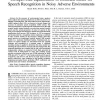73 search results - page 14 / 15 » An Introduction to Application-Independent Evaluation of Spe... |
LREC
2008
13 years 7 months ago
2008
Speech synthesis by unit selection requires the segmentation of a large single speaker high quality recording. Automatic speech recognition techniques, e.g. Hidden Markov Models (...
ICASSP
2011
IEEE
12 years 9 months ago
2011
IEEE
Varying channel conditions present a difficult problem for many speech technologies such as language identification (LID). Channel compensation techniques have been shown to sig...
ISCAS
2006
IEEE
14 years 4 days ago
2006
IEEE
Abstract—We present a silicon neuron with a dynamic, active leak that enables precise spike-timing with respect to a time-varying input signal. Our neuron models the mammalian bu...
TASLP
2010
13 years 26 days ago
2010
In the presence of environmental noise, speakers tend to adjust their speech production in an effort to preserve intelligible communication. The noise-induced speech adjustments, c...
MOBISYS
2010
ACM
13 years 8 months ago
2010
ACM
We present Darwin, an enabling technology for mobile phone sensing that combines collaborative sensing and classification techniques to reason about human behavior and context on ...

